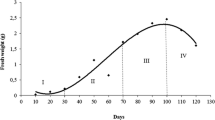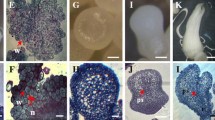Abstract
The present study aimed to evaluate the quality of cell suspension of Coffea arabica cv. Catiguá at four different ages by morphological and gene expression analysis. For this purpose, cell suspension samples were collected at 30, 45, 60 and 75 days. Morphological analysis revealed the presence of embryogenic regions in all samples, and after 60 days, non-embryogenic regions were also identified. The genic analyses revealed that as the cells were transferred to a new medium a change in both their physical and chemical conditions was noticed that caused stress. The decrease in SERK and BBM genes expression after 75th day may also be due to the non-embryogenic regions, characterized by large, elongated and vacuolated cells that were observed in the periphery of embryogenic regions, starting from 60 days of culture.





Similar content being viewed by others
Abbreviations
- MG2:
-
Minas gerais 2
- ECS:
-
Embryogenic cell suspensions
- SERK :
-
Somatic embryogenesis receptor-like kinase
- BBM :
-
Baby Boom
- 2,4-d :
-
2,4-Dichlorophenoxyacetic acid
- IBA:
-
Indole-3-butyric acid
- 2-iP:
-
2-Isopentenyladenine
- qPCR:
-
Real-time quantitative PCR
- PCR:
-
Polymerase chain reaction
- RNA:
-
Ribonucleic acid
- TAE:
-
Tris–acetate–EDTA
- DNAse:
-
Deoxyribonuclease
- cDNA:
-
Complementary DNA
- ml:
-
Milliliters
- μg:
-
Microgram
- ng:
-
Nanogram
- µM:
-
Micromolar
- GAPDH:
-
Glyceraldehyde 3-phosphate dehydrogenase
References
Barsalobres-Cavallari CF, Severino FE, Maluf MP, Maia IG (2009) Identification of suitable internal control genes for expression studies in Coffea arabica under different experimental conditions. BMC Mol Biol 10:1–11. doi:10.1186/1471-2199-10-1
Boutilier K, Offringa R, Sharma V, Kieft H, Ouellet T, Zhang L, Hattori J, Liu C, Van Lammeren A, Miki B, Custers J, Campagne M (2002) Ecotopic expression of BABY BOOM triggers a conversion from vegetative to embryonic growth. Plant Cell 14:1737–1749. doi:10.1105/tpc.001941
Carvalho JMFC, González-Benito E, Perez C (2001) Análise histológica de calogênese e embriogênese das cultivares de algodão cnpa precoce 2 e coker 312. Rev Fibros 5:235–239
Ferreira MGR, Carvalho CHS, Carneiro AA, Damião-Filho CF (2005) Indução de embriogênese somática em cupuaçu (Theobroma grandiflorum Schum). Revista Brasileira de Fruticultura Jaboticabal 3:500–503
Gatica-Arias AM, Arrieta-Espinoza G, Esquivel AME (2008) Plant regeneration via indirect somatic embryogenesis and optimisation of genetic transformation in Coffea arabica L. cvs. Caturra and Catuaí. Electron J Biotechnol 11:1–12. doi: 10.2225/vol11-issue1-fulltext-9
George EF, Hall MA, Klerk GJ (2008) Plant propagation by tissue culture, 3rd edn. The Background, Dordrecht, p 501
Guerra PG, Torres AC, Teixeira JB (1999) Embriogênese somática e sementes sintéticas. In: Torres AC, Caldas LS, Buso LA (eds) Cultura de tecidos e transformação genética de plantas, vol 2. Embrapa, Brasilia, pp 533–568
Heidmann I, Lange B, Lambalk J, Angenent GC, Boutilier K (2011) Efficient sweet pepper transformation mediated by the BABY BOOM transcription factor. Plant Cell Rep 30:1107–1115. doi:10.1007/s00299-011-1018-x
Mahdavi-Darvari F, Noor NM, Ismanizan I (2015) Epigenetic regulation and gene markers as signals of early somatic embryogenesis. Plant Cell Tissue Organ Cult 120:407–422. doi:10.1007/s11240-014-0615-0
Morais TP, Melo B (2011) Biotecnologia aplicada ao melhoramento genético do cafeeiro. Ciência Rural 5:753–760
Morais H, Marur CJ, Caramori PH, Ribeiro AMA, Gomes JC (2003) Características fisiológicas e de crescimento de cafeeiros sombreados com guandu e cultivados a pleno sol. Pesquisa Agropecuária Brasileira 10:1131–1137
Moura EF, Ventrella MC, Motoike SY, Sá AQJR, Carvalho M, Manfio CE (2008) Histological study of somatic embryogenesis induction on zygotic embryos of macaw palm (Acrocomia aculeata (Jacq.) Lodd. ex Martius). Plant Cell Tissue Organ Cult 95:175–184. doi:10.1007/s11240-008-9430-9
Oliveira AC, Pereira AA (2014) CaféPoint. Disponível em: http://www.cafepoint.com.br/radares-tecnicos/variedades-de-cafe/cultivares-de-cafe-arabica-desenvolvidas-pela-epamig-47444n.aspx. Accessed em 17 May 2014
Quiroz-Figueroa FR, Fuentes-Cerda CFJ, Rojas-Herrera R, Loyola-Vargas VM (2002) Histological studies on the developmental stages and differentiation of two different somatic embryogenesis systems of Coffea Arabica. Plant Cell Rep 20:1141–1149. doi:10.1007/s00299-002-0464-x
Ribas AF, Dechamp E, Champion A, Bertrand B, Combes MC, Verdeil J, Lapeyre F, Lashermes P, Etienne H (2011) Agrobacterium-mediated genetic transformation of Coffea arabica (L.) is greatly enhanced by using established embryogenic callus cultures. BMC Plant Biol 11:92. doi:10.1186/1471-2229-11-92
Samson NP, Campa C, Le Gal L, Noirot M, Thomas G, Lokeswari TS, Kochko AD (2006) Effect of primary culture medium composition on high frequency somatic embryogenesis in different Coffea species. Plant Cell Tissue Organ Cult 86:37–45. doi:10.1007/s11240-006-9094-2
Santos MO, Aragão FJL (2009) Role of SERK genes in plant environmental response. Plant Signal Behav 4:1111–1113. doi:10.4161/psb.4.12.9900
Savona M, Mattioli R, Nigro S, Falasca G, Della Rovere F, Costantino P, De Vries S, Ruffoni B, Trovato M, Altamura MM (2011) Two SERK genes are markers of pluripotency in Cyclamen persicum Mill. J Exp Bot 63:471–488. doi:10.1093/jxb/err295
Schellenbaum P, Jacques A, Maillot P (2008) Characterization of VvSERK1, VvSERK2, VvSERK3, and VvLIL genes and their expression during somatic embryogenesis of grapevine (Vitis vinifera L.). Plant Cell Rep 27:1799–1809. doi:10.1007/s00299-008-0588-8
Schmidt ED, Guzzo F, Toonen MA, De Vries SC (1997) A leucine-rich repeat containing receptor-like kinase marks somatic plant cells competent to form embryos. Development 124:2049–2062
Silva AT (2011) Análise da expressão dos genes baby boom (BBM) e somatic embryogenesis receptor kinase (SERK) envolvidos na embriogênese somática do cafeeiro. 2011. 132 f. Dissertação (Mestrado em Biotecnologia Vegetal). Universidade Federal de Lavras, Lavras
Silva AT, Barduche D, Livramento KG, Ligterink W, Paiva LV (2013) Characterization of a putative Serk-like ortholog in embryogenic cell suspension cultures of Coffea arabica L. Plant Mol Biol Rep 32:176–184. doi:10.1007/s11105-013-0632-x
Stein VC et al (2010) Ultrastructural calli analysis of Inga vera Willd. Rev Árvore 34:789–796
Steinmacher DA, Guerra MP, Saare-Surminski K, Lieberei R (2011) A temporary immersion system improves in vitro regeneration of peach palm through secondary somatic embryogenesis. Ann Bot 108:1463–1475. doi:10.1093/aob/mcr033
Acknowledgments
The authors would like to thank Fundação de Amparo à Pesquisa de Minas Gerais (FAPEMIG), Coordenação de Aperfeiçoamento de Pessoal de Nível Superior (CAPES) and Conselho Nacional de Desenvolvimento Científico e Tecnológico (CNPq) for their financial support.
Author information
Authors and Affiliations
Corresponding author
Additional information
Communicated by Y. Wang.
Rights and permissions
About this article
Cite this article
Torres, L.F., Diniz, L.E.C., Do Livramento, K.G. et al. Gene expression and morphological characterization of cell suspensions of Coffea arabica L. cv. Catiguá MG2 in different cultivation stages. Acta Physiol Plant 37, 175 (2015). https://doi.org/10.1007/s11738-015-1924-6
Received:
Revised:
Accepted:
Published:
DOI: https://doi.org/10.1007/s11738-015-1924-6




